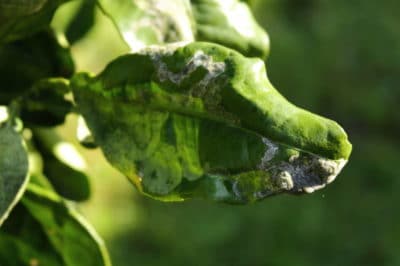Water Stress and Curled Orange Leaves
Orange tree leaves that stay green while their edges begin to curl inward are probably victims of inadequate watering. Unless you take action, the tree is also likely to start losing its flowers and/or fruit. Several factors, including:
- its variety
- its size
- the season
- the location in USDA plant hardiness zones 9 through 11
- the weather
dictate how much water an orange tree needs.
In the dog days of an Arizona July, for example, a tree with a 14-foot canopy goes through nearly 39 gallons of water per day, including rainfall. In mid-December, that drops to 3.7 gallons per day.
The Fix
Water the top 2 feet of soil slowly and deeply from the trunk to just beyond the dripline (where rain drips from the ends of the branches.) A drip system or soaker hose is best.
Water weekly to monthly, depending on your soil and the time of year. Sandy soils drain more quickly than loam or clay.
Expert gardener’s tip: Spreading 3 inches of organic mulch around the tree helps the soil stay moist. Just keep it away from the trunk.
Leaf-Curling Diseases
Bacterial blast disease — aka citrus blast — surfaces with black lesions girdling the leaves’ stems. The leaves curl, wither and fall from the tree.
Botrytis blight spores enter orange trees through wounded bark and cover the injury with fuzzy, grayish mold. Affected twigs develop discolored, curled leaves.
The Fixes
To prevent blast, prune and fertilize in spring. This limits infection-susceptible fall growth.
For botrytis prevention, protect the tree from frost and mechanical damage. Water from beneath to keep its buds and flowers dry.
During rainy springs, applying organic copper spray every 10 days discourages both diseases.
Leaf-Curling Insects
Several sap-sucking insects, including:
- whiteflies
- aphids
- psyllids
- mites
latch onto orange tree leaves and drain the sap from their vascular tissue. Typically, they attack in colonies. Heavily infested leaves become curled, deformed and/or discolored. The insects’ clear, gooey waste often gets covered with black sooty mold.
The Fix
Spray an infested tree with organic insecticidal soap applied until it drips from both sides of all the leaves. Repeat every four days until the pests are gone.
